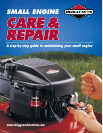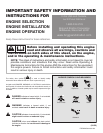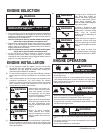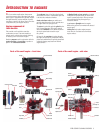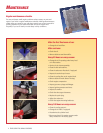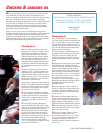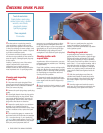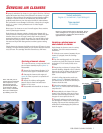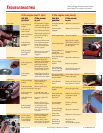
6THE GUIDE TO SMALL ENGINES
Tools & materials:
Spark tester, spark plug
socket (sizes vary), socket
wrench, wire brush,
plug/point cleaner,
spark plug gauge.
Time required:
15 minutes.
T
he electrodes on a spark plug must be
clean and sharp to produce the powerful
spark required for ignition. The more worn
or dirty a spark plug, the more voltage—and
the greater the tug on the rewind—required
to produce an adequate spark.
If you haven’t tuned your engine recently
and have to tug repeatedly on the rewind to
start the engine, a damaged spark plug may
be the culprit.
Luckily, a spark plug is one of the easiest
engine components to repair and an
inexpensive one to replace. And your
standard socket set may already include the
most important tool—a spark plug socket.
Cleaning and inspecting
a spark plug
1. Disconnect the spark plug lead. Then,
clean the area around the spark plug to avoid
getting debris in the combustion chamber
when you remove the plug.
2. Remove the spark plug using a spark plug
socket.
3. Clean light deposits from the plug with a
wire brush and spray-on plug cleaner. Then,
use a sturdy knife if necessary to scrape off
tough deposits. NOTE: Never clean a spark
plug with a shot blaster or abrasives.
4. Inspect the spark plug for very stubborn
deposits, or for cracked porcelain or
electrodes that have been burned away. If any
of these conditions exists, replace the spark
plug.
5. Use a spark plug gauge to measure the
gap between the two electrodes (one straight,
one curved) at the tip of your spark plug
(photo A). Many small engines require a .030"
gap. Check the specifications for your model
with your power equipment dealer. If
necessary, use a spark plug gauge to adjust
the gap by gently bending the curved elec-
trode. When the gap is correct, the gauge will
drag slightly as you pull it through the gap.
6. Reinstall the plug, taking care not to
overtighten. Then, attach the spark plug lead.
Checking ignition with
a spark tester
A spark tester offers an inexpensive, easy way
to diagnose ignition problems (see “Checking
for Spark Miss”).
If you find a problem, remove and inspect the
spark plug. Replace the spark plug if you find
evidence of wear or burning at the spark plug
tip. Spark plugs are inexpensive and a new
one may solve the problem.
1. Connect the spark plug lead to the long
terminal of your tester and ground the tester
to the engine with the tester’s alligator clip
(photo B).
2. Use the rewind or electric starter to crank
the engine, and look for a spark in the tester’s
window.
3. If you see a spark jump the gap in the
tester, the ignition is functioning. The
absence of a visible spark indicates a problem
in the ignition system.
Checking for spark miss
A spark plug that is fouled or improperly
gapped may not allow sparks to jump the gap
between electrodes consistently. The spark
plug will fire erratically or may occasionally
fail to spark. Test for this problem—known as
spark “miss”—if your engine stumbles, with a
noticeable decrease in engine sound. Spark
miss can also cause the engine to emit black
smoke or a popping sound, as unburned fuel
exits with the exhaust and ignites inside the
muffler.
1. With the spark plug screwed into the
cylinder head, attach the spark plug lead to
the long terminal of the spark tester. Attach
the tester’s alligator clip to the spark plug
(photo C).
2. Start the engine and watch the tester’s
spark gap. You’ll recognize spark miss by the
uneven timing of the sparks in the tester.
A
B C
CHECKING SPARK PLUGS



